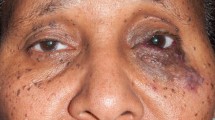Abstract
Purpose
The superficial venous system (SVS) of the neck receives blood from the face and oral cavity. The SVS comprises the anterior jugular vein (AJV), external jugular vein (EJV), and facial vein (FV). Comprehensive knowledge of the normal anatomy and potential variations in the venous system is valuable in surgical and radiological procedures. This study aimed to update the anatomic knowledge of the SVS using a radiographic approach, which is a beneficial data source in clinical practice.
Methods
Contrast-enhanced computed tomography images of the neck of patients with head and neck cancer treated between 2017 and 2020 were retrospectively evaluated. Each side of the neck was counted separately. A total of 302 necks of 151 patients were enrolled in this study.
Results
The medial AJV was absent in 49.7% (75/151) of the patients on the left side, which was significantly greater than the 19.2% (29/151) on the right (p < 0.001). The left AJV drained into the right venous system in 6.6% (10/151) of the necks. In 48.3% (146/302) of the necks, the FV did not flow into the internal jugular vein but rather into the EJV or AJV; these findings were significantly more frequent than those reported in previous studies. The diameters of the veins were significantly larger when they received blood from the FV than when they were not connected to the FV.
Conclusion
These findings indicate that the AJV has a rightward preference during its course. The course of the FV is diverse and affects the diameter of connected veins.




Similar content being viewed by others
Data availability
Dataset is available on request to the author for sole purpose of validating the present study.
References
Anehosur V, Rajendiran S, Jayade GR, Kumar N (2016) An unusual observation during neck dissection. J Maxillofac Oral Surg 15:306–308. https://doi.org/10.1007/s12663-015-0839-5
Chauhan NK, Rani A, Chopra J et al (2011) Anomalous formation of external jugular vein and its clinical implication. Natl J Maxillofac Surg 2:51–53. https://doi.org/10.4103/0975-5950.85854
Choudhry R, Tuli A, Choudhry S (1997) Facial vein terminating in the external jugular vein. An embryologic interpretation. Surg Radiol Anat 19:73–77
Cotofana S, Steinke H, Schlattau A et al (2017) The anatomy of the facial vein: implications for plastic, reconstructive, and aesthetic procedures. Plast Reconstr Surg 139:1346–1353. https://doi.org/10.1097/PRS.0000000000003382
Cvetko E (2015) A case of left-sided absence and right-sided fenestration of the external jugular vein and a review of the literature. Surg Radiol Anat 37:883–886. https://doi.org/10.1007/s00276-014-1398-z
Dalip D, Iwanaga J, Loukas M et al (2018) Review of the variations of the superficial veins of the neck. Cureus 10:e2826. https://doi.org/10.7759/cureus.2826
Deslaugiers B, Vaysse P, Combes JM et al (1994) Contribution to the study of the tributaries and the termination of the external jugular vein. Surg Radiol Anat 16:173–177. https://doi.org/10.1007/BF01627591
Gupta V, Tuli A, Choudhry R et al (2003) Facial vein draining into external jugular vein in humans: its variations, phylogenetic retention and clinical relevance. Surg Radiol Anat 25:36–41. https://doi.org/10.1007/s00276-002-0080-z
Nayak BS (2006) Surgically important variations of the jugular veins. Clin Anat 19:544–546. https://doi.org/10.1002/ca.20268
Schummer W, Schummer C, Bredle D, Fröber R (2004) The anterior jugular venous system: variability and clinical impact. Anesth Analg 99:1625–1629. https://doi.org/10.1213/01.ane.0000138038.33738.32
Shima H, von Luedinghausen M, Ohno K, Michi K (1998) Anatomy of microvascular anastomosis in the neck. Plast Reconstr Surg 101:33–41. https://doi.org/10.1097/00006534-199801000-00007
Stickle BR, McFarlane H (1997) Prediction of a small internal jugular vein by external jugular vein diameter. Anesthesia 52:220–222. https://doi.org/10.1111/j.1365-2044.1997.078-az0076.x
Umek N, Cvetko E (2019) Unusual course and termination of common facial vein: a case report. Surg Radiol Anat 41:239–241. https://doi.org/10.1007/s00276-018-2129-7
Vaida M-A, Niculescu V, Motoc A et al (2006) Correlations between anomalies of jugular veins and areas of vascular drainage of head and neck. Rom J Morphol Embryol 47:287–290
Williams DW (1997) An imager’s guide to normal neck anatomy. Seminars in Ultrasound, CT and MRI 18:157–181
Funding
The authors did not receive support from any organization for the submitted work.
Author information
Authors and Affiliations
Contributions
K Honda: Project development, Data collection, Data analysis, Manuscript writing; K Omori: Project development, Supervision, critical appraisal; Y Kishimoto: Project development.
Corresponding author
Ethics declarations
Conflict of interest
The authors have no relevant financial or non-financial interests to disclose.
Ethical approval
This study was approved by the Kyoto University Graduate School and Faculty of Medicine Ethics Committee (R3255-1).
Patient consent
The Ethics Committee waived the requirement for obtaining written consent from each patient because of the study’s retrospective, noninvasive, and personally unidentifiable nature.
Additional information
Publisher's Note
Springer Nature remains neutral with regard to jurisdictional claims in published maps and institutional affiliations.
Rights and permissions
Springer Nature or its licensor (e.g. a society or other partner) holds exclusive rights to this article under a publishing agreement with the author(s) or other rightsholder(s); author self-archiving of the accepted manuscript version of this article is solely governed by the terms of such publishing agreement and applicable law.
About this article
Cite this article
Honda, K., Omori, K. & Kishimoto, Y. Anatomical variations in the superficial venous system of the neck: an image-based study using contrast-enhanced computed tomography. Surg Radiol Anat (2024). https://doi.org/10.1007/s00276-024-03326-9
Received:
Accepted:
Published:
DOI: https://doi.org/10.1007/s00276-024-03326-9




